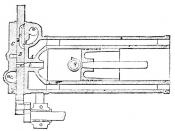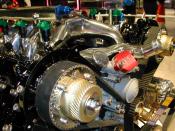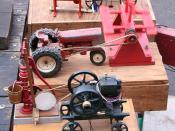An internal-combustion engine is a heat engine that burns fuel and air inside a combustion
chamber located within the engine proper. Simply stated, a heat engine is an engine that
converts heat energy to mechanical energy. The internal- combustion engine should be
distinguished from the external- combustion engine, for example, the steam engine and the
Stirling engine, which burns fuel outside the prime mover, that is, the device that actually produces mechanical motion. Both basic types produce hot, expanding gases, which may then be employed to move pistons, turn turbine rotors, or cause locomotion through the reaction principle as they escape through the nozzle.
Most people are familiar with the internal-combustion reciprocating engine, which is used to
power most automobiles, boats, lawn mowers, and home generators. Based on the means of
ignition, two types of internal-combustion reciprocating engines can be distinguished:
spark-ignition engines and compression-ignition engines. In the former, a spark ignites a
combustible mixture of air and fuel; in the latter, high compression raises the temperature of the
air in the chamber and ignites the injected fuel without a spark.
The diesel engine is a
compression-ignition engine. This article emphasizes the spark-ignition engine.
The invention and early development of internal-combustion engines are usually credited to
three Germans. Nikolaus Otto patented and built (1876) the first such engine; Karl Benz built
the first automobile to be powered by such an engine (1885); and Gottlieb Daimler designed the
first high-speed internal-combustion engine (1885) and carburetor. Rudolf Diesel invented a
successful compression-ignition engine (the diesel engine) in 1892.
The operation of the internal-combustion reciprocating engine employs either a four-stroke
cycle or a two-stroke cycle. A stroke is one continuous movement of the piston within the
cylinder.
In the four-stroke cycle, also known as the Otto cycle, the downward movement of...


